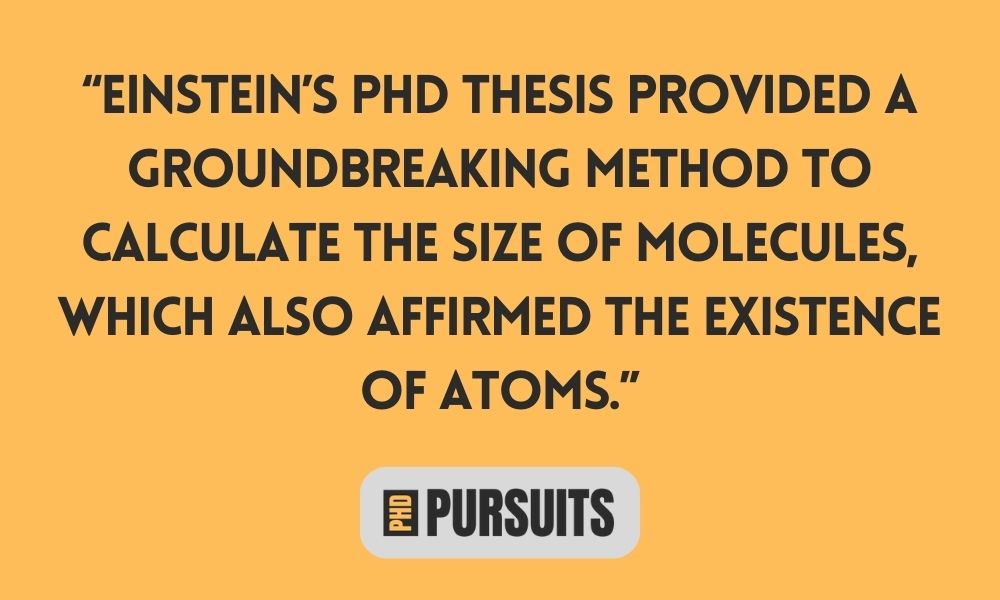If you think a PhD thesis or dissertation needs to be thick and have hundred’s of pages, think again. PhD research can be short and incredibly succinct, and may surprise you. What are the world’s shortest PhD thesis?
At this point, the shortest PhD thesis may be David Lee Rector’s “An Unstable Adams Spectral Sequence.” This is a mathematical thesis submitted to MIT in 1966, and is only 9 pages long.
In this post, let’s look at the 5 shortest PhD theses and dissertations, including from scientific giants like Albert Einstrin and John Nash.
Shortest PhD Thesis / Dissertation
| Author | Title | Field | Number of Pages |
|---|---|---|---|
| John Nash | Non-Cooperative Games | Mathematics | 26 |
| Albert Einstein | A New Determination of Molecular Dimensions | Physics | 17 |
| Edmund Landau | New Proof of the Equation | Mathematics | 16 |
| Burt Totaro | Milnor K-Theory is the Simplest Part of Algebraic K-Theory | Mathematics | 13 |
| David Lee Rector | An Unstable Adams Spectral Sequence | Mathematics | 9 |
24 pages – John Nash: Non-Cooperative Games (1950)
John Nash’s PhD thesis on “Non-Cooperative Games” is a legendary document in the field of mathematics. Spanning just 26 pages, it’s among the shortest PhD dissertations but don’t let its brevity fool you.
Inside, Nash introduces the Nash equilibrium concept, a revolutionary idea in game theory. His work, done at Princeton, became a cornerstone in economics, earning him the Nobel Prize.

Unlike typical dissertations with lengthy bibliographies and extensive proofs, Nash’s paper is concise, with just two citations.
It’s a masterclass in clarity and brevity, showcasing that sometimes the most profound ideas need only a few pages to be expressed fully.
This piece is a testament to Nash’s brilliance and a reminder of the impact of powerful, succinct academic work.
17 pages – Albert Einstein: A New Determination of Molecular Dimensions (1906)
In Albert Einstein’s doctoral dissertation, “A New Determination of Molecular Dimensions,” he provided a groundbreaking method to calculate the size of molecules, which also affirmed the existence of atoms.

His work combined empirical data with theoretical physics, bridging the gap between abstract concepts and measurable reality.
This thesis is celebrated not just for its scientific significance but for its innovative approach, mixing theory with practical application.
Einstein’s ability to see beyond the established norms and connect disparate ideas set the stage for his later revolutionary theories.
16 pages – Edmund Landau: New Proof of the Equation (1899)
Edmund Landau submitted this thesis in German to graduate with a PhD in mathematics from Friedrich–Wilhelms University in Berlin in 1899. M.J. Coons later translated the thesis into English in 2007.
This made significant contributions to number theory by providing a new proof of an important equation.
Landau’s work is known for its rigorous approach and clear presentation, setting a standard in mathematical proofs. His thesis is often cited for its methodological innovation and precision, illustrating Landau’s early mastery of complex mathematical concepts.
This work laid the groundwork for his later achievements and established him as a key figure in the mathematical community.
13 pages – Burt Totaro: Milnor K-Theory is the Simplest Part of Algebraic K-Theory (1992)
Burt Totaro’s thesis, “Milnor K-Theory is the Simplest Part of Algebraic K-Theory,” presented in 1992, marks a significant contribution to mathematical science.
In this work, Totaro explored the depths of K-Theory, a field that intertwines algebra and topology, providing insights into the structure and classification of algebraic varieties.
His focus on Milnor K-Theory, a more approachable segment of the broader Algebraic K-Theory, shed light on its foundational elements and implications for complex mathematical structures.
Totaro’s dissertation, recognized for its clarity and depth, helped demystify some of the intricate aspects of K-Theory, making it more accessible to fellow researchers and mathematicians.
His work is a testament to the power of simplifying complex ideas without losing their essence, a skill that has made his thesis a valuable resource in academia.
9 pages – David Lee Rector: An Unstable Adams Spectral Sequence (1966)
And the ultimate winner for the world’s shortest PhD thesis is… David Lee Rector.
This thesis was submitted to Massachusetts Institute of Technology (MIT) in 1966, for him to earn his doctorate. It is only 9 pages long!

The thesis, “An Unstable Adams Spectral Sequence,” has a special place with mathematicians. Many academic recognize the thesis’s innovative approach to algebraic topology.
His work answered and contributed to the understanding of spectral sequences, a math tool used to compute homotopy groups and solve complex problems in topology.
Rector’s insights and methods provided a new perspective on the Adams spectral sequence, particularly focusing on its instability and applications.
His contributions have been valuable for further research in the field, offering a deeper understanding of algebraic and topological structures.
How Many Pages Do PhD Thesis Or Dissertation Usually Have?
The length of a PhD thesis or dissertation can vary widely depending on the:
- field of study,
- university requirements, and
- the nature of the research.
Generally, the average length falls between 100 to 300 pages, though there are notable exceptions on both ends of the spectrum.
Some dissertations in the humanities can exceed 300 pages, while those in the sciences may be shorter, focusing more on data and less on extensive literature review.
This is because STEM researches usually present more concise documents, heavily centered on data and succinct conclusions, often resulting in shorter lengths.
Each thesis or dissertation is unique, tailored to the depth and breadth of its specific inquiry. Long or short does not matter as much as, providing findings that contribute to the present knowledge.
Shortest PhD Thesis / Dissertation
The exploration of the top 5 shortest PhD theses reveals the profound impact succinct work can have on academia. These remarkable documents challenge conventional norms around dissertation length, showing how groundbreaking ideas can be short and succint.
Each thesis stands as a testament to efficiency and clarity in academic research, showcasing how significant contributions to knowledge can emerge from conciseness and precision in scholarly work.

Dr. JW Ong holds academic degrees, including a Ph.D. in Applied Linguistics from universities in New Zealand, Malaysia, and the UK. He started PhDPursuits.com as a way to share the experience he wish he would have had known before embarking on his PhD.

